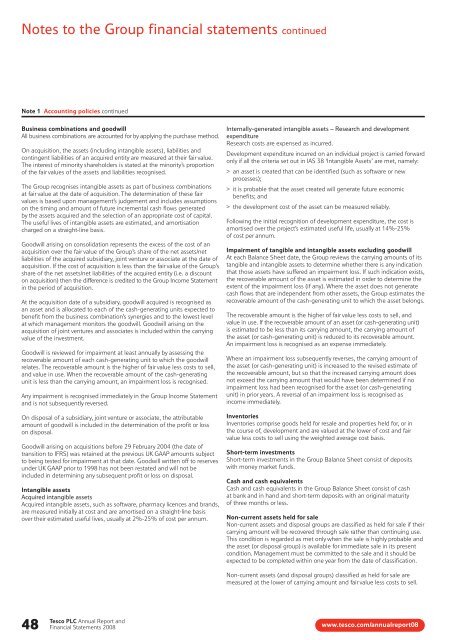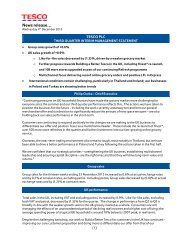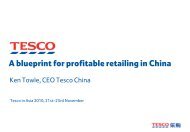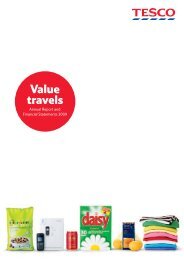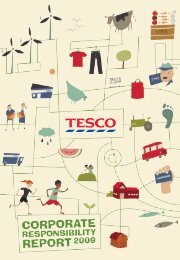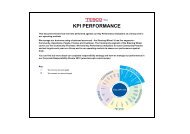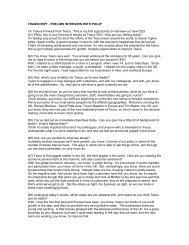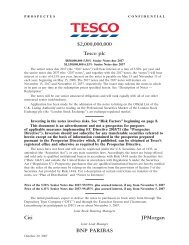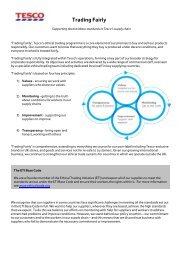Tesco plc Annual Report and Financial Statements 2008
Tesco plc Annual Report and Financial Statements 2008
Tesco plc Annual Report and Financial Statements 2008
Create successful ePaper yourself
Turn your PDF publications into a flip-book with our unique Google optimized e-Paper software.
Notes to the Group financial statements continued<br />
Note 1 Accounting policies continued<br />
Business combinations <strong>and</strong> goodwill<br />
All business combinations are accounted for by applying the purchase method.<br />
On acquisition, the assets (including intangible assets), liabilities <strong>and</strong><br />
contingent liabilities of an acquired entity are measured at their fair value.<br />
The interest of minority shareholders is stated at the minority’s proportion<br />
of the fair values of the assets <strong>and</strong> liabilities recognised.<br />
The Group recognises intangible assets as part of business combinations<br />
at fair value at the date of acquisition. The determination of these fair<br />
values is based upon management’s judgement <strong>and</strong> includes assumptions<br />
on the timing <strong>and</strong> amount of future incremental cash flows generated<br />
by the assets acquired <strong>and</strong> the selection of an appropriate cost of capital.<br />
The useful lives of intangible assets are estimated, <strong>and</strong> amortisation<br />
charged on a straight-line basis.<br />
Goodwill arising on consolidation represents the excess of the cost of an<br />
acquisition over the fair value of the Group’s share of the net assets/net<br />
liabilities of the acquired subsidiary, joint venture or associate at the date of<br />
acquisition. If the cost of acquisition is less than the fair value of the Group’s<br />
share of the net assets/net liabilities of the acquired entity (i.e. a discount<br />
on acquisition) then the difference is credited to the Group Income Statement<br />
in the period of acquisition.<br />
At the acquisition date of a subsidiary, goodwill acquired is recognised as<br />
an asset <strong>and</strong> is allocated to each of the cash-generating units expected to<br />
benefit from the business combination’s synergies <strong>and</strong> to the lowest level<br />
at which management monitors the goodwill. Goodwill arising on the<br />
acquisition of joint ventures <strong>and</strong> associates is included within the carrying<br />
value of the investment.<br />
Goodwill is reviewed for impairment at least annually by assessing the<br />
recoverable amount of each cash-generating unit to which the goodwill<br />
relates. The recoverable amount is the higher of fair value less costs to sell,<br />
<strong>and</strong> value in use. When the recoverable amount of the cash-generating<br />
unit is less than the carrying amount, an impairment loss is recognised.<br />
Any impairment is recognised immediately in the Group Income Statement<br />
<strong>and</strong> is not subsequently reversed.<br />
On disposal of a subsidiary, joint venture or associate, the attributable<br />
amount of goodwill is included in the determination of the profit or loss<br />
on disposal.<br />
Goodwill arising on acquisitions before 29 February 2004 (the date of<br />
transition to IFRS) was retained at the previous UK GAAP amounts subject<br />
to being tested for impairment at that date. Goodwill written off to reserves<br />
under UK GAAP prior to 1998 has not been restated <strong>and</strong> will not be<br />
included in determining any subsequent profit or loss on disposal.<br />
Intangible assets<br />
Acquired intangible assets<br />
Acquired intangible assets, such as software, pharmacy licences <strong>and</strong> br<strong>and</strong>s,<br />
are measured initially at cost <strong>and</strong> are amortised on a straight-line basis<br />
over their estimated useful lives, usually at 2%-25% of cost per annum.<br />
48<br />
<strong>Tesco</strong> PLC <strong>Annual</strong> <strong>Report</strong> <strong>and</strong><br />
<strong>Financial</strong> <strong>Statements</strong> <strong>2008</strong><br />
Internally-generated intangible assets – Research <strong>and</strong> development<br />
expenditure<br />
Research costs are expensed as incurred.<br />
Development expenditure incurred on an individual project is carried forward<br />
only if all the criteria set out in IAS 38 ‘Intangible Assets’ are met, namely:<br />
> an asset is created that can be identified (such as software or new<br />
processes);<br />
> it is probable that the asset created will generate future economic<br />
benefits; <strong>and</strong><br />
> the development cost of the asset can be measured reliably.<br />
Following the initial recognition of development expenditure, the cost is<br />
amortised over the project’s estimated useful life, usually at 14%-25%<br />
of cost per annum.<br />
Impairment of tangible <strong>and</strong> intangible assets excluding goodwill<br />
At each Balance Sheet date, the Group reviews the carrying amounts of its<br />
tangible <strong>and</strong> intangible assets to determine whether there is any indication<br />
that those assets have suffered an impairment loss. If such indication exists,<br />
the recoverable amount of the asset is estimated in order to determine the<br />
extent of the impairment loss (if any). Where the asset does not generate<br />
cash flows that are independent from other assets, the Group estimates the<br />
recoverable amount of the cash-generating unit to which the asset belongs.<br />
The recoverable amount is the higher of fair value less costs to sell, <strong>and</strong><br />
value in use. If the recoverable amount of an asset (or cash-generating unit)<br />
is estimated to be less than its carrying amount, the carrying amount of<br />
the asset (or cash-generating unit) is reduced to its recoverable amount.<br />
An impairment loss is recognised as an expense immediately.<br />
Where an impairment loss subsequently reverses, the carrying amount of<br />
the asset (or cash-generating unit) is increased to the revised estimate of<br />
the recoverable amount, but so that the increased carrying amount does<br />
not exceed the carrying amount that would have been determined if no<br />
impairment loss had been recognised for the asset (or cash-generating<br />
unit) in prior years. A reversal of an impairment loss is recognised as<br />
income immediately.<br />
Inventories<br />
Inventories comprise goods held for resale <strong>and</strong> properties held for, or in<br />
the course of, development <strong>and</strong> are valued at the lower of cost <strong>and</strong> fair<br />
value less costs to sell using the weighted average cost basis.<br />
Short-term investments<br />
Short-term investments in the Group Balance Sheet consist of deposits<br />
with money market funds.<br />
Cash <strong>and</strong> cash equivalents<br />
Cash <strong>and</strong> cash equivalents in the Group Balance Sheet consist of cash<br />
at bank <strong>and</strong> in h<strong>and</strong> <strong>and</strong> short-term deposits with an original maturity<br />
of three months or less.<br />
Non-current assets held for sale<br />
Non-current assets <strong>and</strong> disposal groups are classified as held for sale if their<br />
carrying amount will be recovered through sale rather than continuing use.<br />
This condition is regarded as met only when the sale is highly probable <strong>and</strong><br />
the asset (or disposal group) is available for immediate sale in its present<br />
condition. Management must be committed to the sale <strong>and</strong> it should be<br />
expected to be completed within one year from the date of classification.<br />
Non-current assets (<strong>and</strong> disposal groups) classified as held for sale are<br />
measured at the lower of carrying amount <strong>and</strong> fair value less costs to sell.<br />
www.tesco.com/annualreport08


